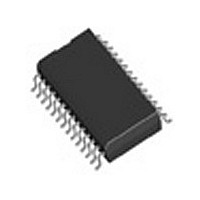AD7874AR-REEL Analog Devices Inc, AD7874AR-REEL Datasheet - Page 8

AD7874AR-REEL
Manufacturer Part Number
AD7874AR-REEL
Description
Manufacturer
Analog Devices Inc
Datasheet
1.AD7874AR-REEL.pdf
(16 pages)
Specifications of AD7874AR-REEL
Number Of Elements
1
Resolution
12Bit
Architecture
SAR
Sample Rate
116KSPS
Input Polarity
Bipolar
Input Type
Voltage
Rated Input Volt
±10V
Differential Input
No
Power Supply Requirement
Dual
Single Supply Voltage (typ)
Not RequiredV
Single Supply Voltage (min)
Not RequiredV
Single Supply Voltage (max)
Not RequiredV
Dual Supply Voltage (typ)
±5V
Dual Supply Voltage (min)
±4.75V
Dual Supply Voltage (max)
±5.25V
Power Dissipation
150mW
Differential Linearity Error
±1LSB
Integral Nonlinearity Error
±1LSB
Operating Temp Range
-40C to 85C
Operating Temperature Classification
Industrial
Mounting
Surface Mount
Pin Count
28
Package Type
SOIC W
Input Signal Type
Single-Ended
Lead Free Status / Rohs Status
Not Compliant
AD7874
The first read operation to the AD7874 after conversion always
accesses data from Data Register 1 (i.e., the conversion result
from the V
RD during this first read operation. The second read always ac-
cesses data from Data Register 2 and so on. The address pointer
is reset to point to Data Register 1 on the rising edge of
CONVST. A read operation to the AD7874 should not be at-
tempted during conversion. The timing diagram for the
AD7874 conversion sequence is shown in Figure 7.
AD7874 DYNAMIC SPECIFICATIONS
The AD7874 is specified and 100% tested for dynamic perfor-
mance specifications as well as traditional dc specifications such
as Integral and Differential Nonlinearity. These ac specifications
are required for the signal processing applications such as
phased array sonar, adaptive filters and spectrum analysis.
These applications require information on the ADC’s effect on
the spectral content of the input signal. Hence, the parameters
for which the AD7874 is specified include SNR, harmonic dis-
tortion, intermodulation distortion and peak harmonics. These
terms are discussed in more detail in the following sections.
Signal-to-Noise Ratio (SNR)
SNR is the measured signal to noise ratio at the output of the
ADC. The signal is the rms magnitude of the fundamental.
Noise is the rms sum of all the nonfundamental signals up to
half the sampling frequency (fs/2) excluding dc. SNR is depen-
dent upon the number of quantization levels used in the digiti-
zation process; the more levels, the smaller the quantization
noise. The theoretical signal to noise ratio for a sine wave input
is given by
where N is the number of bits.
Thus for an ideal 12-bit converter, SNR = 74 dB.
The output spectrum from the ADC is evaluated by applying a
sine wave signal of very low distortion to the V
sampled at a 29 kHz sampling rate. A Fast Fourier Transform
(FFT) plot is generated from which the SNR data can be ob-
tained. Figure 8 shows a typical 2048 point FFT plot of the
AD7874BN with an input signal of 10 kHz and a sampling
frequency of 29 kHz. The SNR obtained from this graph is
73.2 dB. It should be noted that the harmonics are taken into
account when calculating the SNR.
CONVST
DATA
TIMES
INT
CS
RD
t
2
SNR = (6.02N + 1.76) dB
HIGH-IMPEDANCE
,
t
IN1
3
,
t
Figure 7. AD7874 Timing Diagram
4
,
input). INT is reset high on the falling edge of
t
1
t
6
,
t
TRACK/HOLDS GO
INTO HOLD
7
, AND
t
CONV
t
t
8
2
t
ARE THE SAME FOR ALL FOUR READ OPERATIONS.
6
t
DATA
CH1
3
t
5
t
HIGH-
8
Z
t
t
4
7
DATA
CH2
t
ACQUISITION
HIGH-
Z
DATA
CH3
IN
HIGH-
input which is
Z
DATA
CH4
HIGH-Z
(1)
–8–
Effective Number of Bits
The formula given in Equation 1 relates the SNR to the number
of bits. Rewriting the formula, as in Equation 2, it is possible to
get a measure of performance expressed in effective number of
bits (N).
The effective number of bits for a device can be calculated di-
rectly from its measured SNR.
Figure 9 shows a typical plot of effective number of bits versus
frequency for an AD7874BN with a sampling frequency of
29 kHz. The effective number of bits typically falls between
11.75 and 11.87 corresponding to SNR figures of 72.5 dB and
73.2 dB.
Figure 9. Effective Numbers of Bits vs. Frequency
N
SNR 1.76
Figure 8. AD7874 FFT Plot
6.02
z
REV. C
(2)












